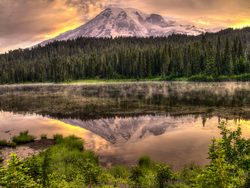
Mount Rainier National Park
Quick Navigation
Mount Rainier National Park is located in the central part of the state of Washington, United States. The park is seated just southeast of Seattle and can be seen from the city on a clear day. The park covers an area of 369.3 square miles (956.6 sq km).
This was the fifth national park established in the United States with Mount Rainier serving as the pinnacle attraction of the park. This renowned mountain is so astounding because of the steep rise in elevation. Varying views of Mount Rainier reveal this vertical rise and often leaves people mesmerized.
The lower elevation of the national park starts at 1,600 feet (490 m) and rises dramatically to the summit of Mount Rainier at 14,411 feet (4,392 m). The area around Mount Rainier is comprised of valleys, forests, meadows, glaciers, rivers, and waterfalls. These facets of nature creating exquisite landscapes with Mount Rainier serving as the backdrop.
There are over 25 glaciers found on the mountain creating the most populous collective of glaciers in the contiguous 48 states. Emmons Glacier covers the most area at 4.3 square miles (11 sq km) whereas Carbon Glacier is the largest based on volume.
Carbon Glacier terminal point occurs at 3,500 feet (1,100 m) establishing it as the lowest elevation glacier in the lower 48 states and Emmons is the largest covered area in the lower 48 states. These add to the aesthetics and statistical significance of the national park.
The pristine wilderness of Mount Rainier National Park serves as the home for an array of wildlife species that make for exciting animal sightings. Some of the more popular species include beaver, black bear, bobcat, cougar, coyote, deer, elk, and mountain goat.
This national park is also a great place for birdwatching as well. The golden eagle and bald eagle are two of the prized sightings that complement the owls, jays, falcons, and other bird species found within the park’s boundaries.
Highlights
Mount Rainier National Park is one of the easy day trips out of Seattle or Tacoma Washington. As the highest point in the Cascades, it is the highlight of the national park. The park also features multiple visitor centers, a museum, and other historical structures that add to the intrigue of the visit.
 Mount Rainier
Mount Rainier
Mount Rainier is an active stratovolcano. It has a summit of 14,411 feet (4,392 m) and is the tallest mountain in the Cascade mountain range. It is the most glaciated mountain in the lower 48 contiguous states serving as the source for five key rivers. There are 25 glaciers spread across the different sides of the mountain.
Approximately half of the 10,000 summit attempts are successful annually. This is one of the most popular mountain summits in the United States. Reaching the top of the mountain is quite an accomplishment as well as receiving astounding views of the forested area below.
Paradise
This is the most commonly visited part of the park. The visitor center and historical buildings add to the aesthetics of the subalpine valley. It also gives access to trails that provide views of the eight waterfalls found on the Paradise River.
Longmire
Longmire offers another visitor center, Longmire Museum, and the famous Mount Rainier National Park Inn. This is the second most popular destination within the park boundaries. It is also one of the starting points of the Wonderland Trail which travels the circumference of the mountain.
Sunrise
The Sunrise Visitor Center is located at the highest point of the park that is accessible by automobile. The center is located at an elevation of 6,400 feet (1,950 m). There are several hiking trails accessible from this location that provide views and experiences with the mountain and surrounding terrain.
Mount Rainier National Park Trails
There are over 100 miles of trails around and throughout the national park. Hiking up the pinnacle summit is only attempted about 10,000 times a year, with most people engaging the shorter trails on and around the mountain.
Mount Rainier Highlights
- Mount Rainier
- Paradise
- Longmire
- Sunrise
Park Map
Sources
- All Trails, Best Trails in Mount Rainier National Park, https://www.alltrails.com/parks/us/washington/mount-rainier-national-park retrieved June 2020.
- Britannica, Mount Rainier, https://www.britannica.com/place/Mount-Rainier, retrieved June 2020.
- Britannica, Mount Rainier National Park, https://www.britannica.com/place/Mount-Rainier-National-Park, retrieved June 2020.
- National Geographic, Complete National Parks of the United States, National Geographic Publishing, Washington DC.
- National Geographic., Everything to Know about Mount Rainier National Park, https://www.nationalgeographic.com/travel/national-parks/mount-rainier-national-park/, retrieved June 2020.
- National Geographic, Guide to the National Parks of the United States, National Geographic Society, 2003.
- National Geographic, National Parks of North America, Canada-United States-Mexico, National Geographic Society, 1995.
- National Park Service, Mount Rainier, https://www.nps.gov/mora/index.htm, retrieved June 2020.
- US News, Mount Rainier National Park, https://travel.usnews.com/Mount_Rainier_National_Park_WA/, retrieved June 2020.












